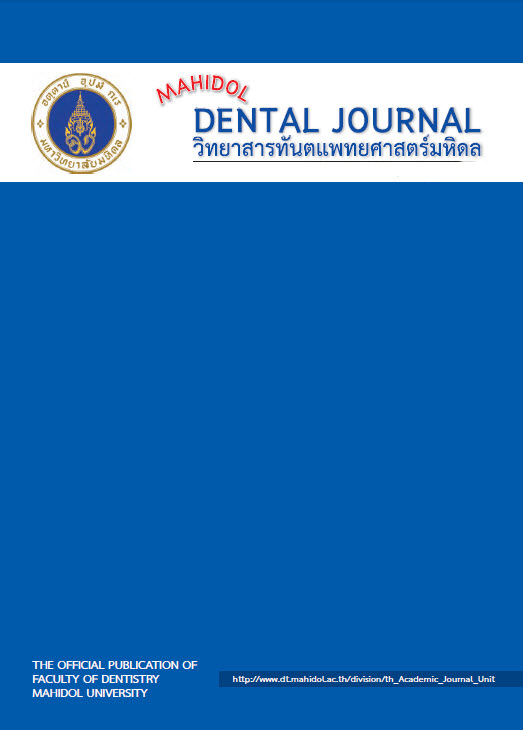The effect of curing methods for dental adhesive on microleakage and marginal adaptation of porcelain laminate veneer
Main Article Content
Abstract
Objective: To compare microleakage and marginal adaptation between precured and non-precured methods of two luting cements on IPS e.max® Press laminate veneer.
Materials and Methods: Thirty-six maxillary central incisors were prepared and IPS e.max® Press HT laminate veneers were fabricated by pressable ceramic system. All laminate veneer specimens were randomly divided into two groups for cementation according to two different luting cements: Rely-x® (Rx) and Vitique® (V). In both resin cement groups, half of laminate veneers was cemented by using precure (PC) of dental adhesive and another half was cemented by using non-precure (NPC) of dental adhesive. Therefore, four experimental groups were created: Rx-PC, Rx-NPC, V-PC and V-NPC (N=9 in each group). After cementation, all specimens were subjected to thermocycling (500 cycles in water) before immersion in 2% methylene blue for 24 h. All bonded teeth specimens were sectioned into three halves in labio-palatal direction. The microleakage and marginal adaptation were measured at the incisal and cervical margins. The data were statistically analyzed using T-test and Mann-Whitney test at a significance level of 0.05.
Results: There is no statistically significant difference of marginal gap and microleakage between precure and non-precure groups at cervical and incisal margins regardless of both resin cements (P>0.05).
Conclusions: Precure and non-precure methods on total etch dental adhesive system did not affect marginal adaptation and microleakage of IPS e.max® Press laminate veneer.
Article Details
References
Calamia JR, Calamia CS. Porcelain laminate veneers: reasons for 25 years of success. Dent Clin North Am. 2007; 51: 399-417.
Celik C, Gemalmaz D. Comparison of marginal integrity of ceramic and composite veneer restorations luted with two different resin agents: an in vitro study. Int J Prosthodont. 2002;15:59-64.
Shinkai K, Suzuki S, Leinfelder KF, Katoh Y. Effect of gap dimension on wear resistance of luting agents. Am J Dent. 1995;8:149-51.
Tjan AH, Dunn JR, Sanderson IR. Microleakage patterns of porcelain and castable ceramic laminate veneers. J Prosthet Dent. 1989;61:276-82.
Haralur SB. Microleakage of porcelain laminate veneers cemented with different bonding techniques. J Clin Exp Dent. 2018;10:e166-e71.
Sorensen JA, Strutz JM, Avera SP, Materdomini D. Marginal fidelity and microleakage of porcelain veneers made by two techniques. J Prosthet Dent. 1992;67:16-22.
Maleknejad F, Moosavi H, Shahriari R, Sarabi N, Shayankhah T. The effect of different adhesive types and curing methods on microleakage and the marginal adaptation of composite veneers. J Contemp Dent Pract. 2009;10:18-26.
Kidd EA. Microleakage: a review. J Dent. 1976;4:199-206.
Frankenberger R, Sindel J, Kramer N, Petschelt A. Dentin bond strength and marginal adaptation: direct composite resins vs ceramic inlays. Oper Dent. 1999; 24:147-55.
Hahn P, Schaller H, Hafner P, Hellwig E. Effect of different luting procedures on the seating of ceramic inlays. J Oral rehabil. 2000; 27:1-8.
Coelho Santos MJ, Navarro MF, Tam L, McComb D. The effect of dentin adhesive and cure mode on film thickness and microtensile bond strength to dentin in indirect restorations. Oper Dent. 2005;30:50-7.
Lien W, Roberts HW, Platt JA, Vandewalle KS, Hill TJ, Chu TM. Microstructural evolution and physical behavior of a lithium disilicate glass-ceramic. Dental Mater. 2015;31:928-40.
McLean JW, von Fraunhofer JA. The estimation of cement film thickness by an in vivo technique. Br Dental J. 1971;131:107-11.
Colpani JT, Borba M, Della Bona A. Evaluation of marginal and internal fit of ceramic crown copings. Dent Mater.2013;29:174-80.
Hofmann N, Papsthart G, Hugo B, Klaiber B. Comparison of photo-activation versus chemical or dual-curing of resin-based luting cements regarding flexural strength, modulus and surface hardness. J Oral rehabil. 2001;28:1022-8.
Scotti N, Comba A, Cadenaro M, Fontanive L, Breschi L, Monaco C, et al. Effect of Lithium Disilicate Veneers of Different Thickness on the Degree of Conversion and Microhardness of a Light-Curing and a Dual-Curing Cement. Int J Prosthodont.2016;29:384-8.
Runnacles P, Correr GM, Baratto Filho F, Gonzaga CC, Furuse AY. Degree of conversion of a resin cement light-cured through ceramic veneers of different thicknesses and types. Braz Dent J. 2014;25:38-42.


